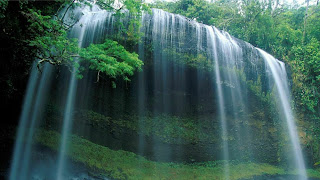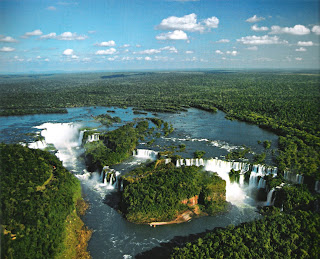Top 10 Highest Waterfalls in India
>> Friday, October 14, 2011
Kunchikal Falls: The Kunchikal Falls is the highest waterfalls in India and second highest in Asia. The tallest waterfall of India with a height of 1,493 ft is located near Agumbe in Shimoga district of Karnatak. Agumbe is among the places in India that receive very heavy rainfall and it has the only permanent rain forest research station in India. The India’s biggest waterfall is formed by the Varahi River and lies in the Western Ghats. The Ghats is well famous for its Giant Indian squirrel, Indian bullfrog and other unique birds, rare reptiles and bizarre wild animals.
Barehipani Falls: The Barehipani is a picturesque waterfall situated in the core area of Simlipal National Park in Mayurbhanj district of Orissa. This waterfall is second highest waterfalls of India with a height of 1,309 ft. The gorgeous fall is surrounded by deep forest which again adds the wildness to its beauty. This two-tiered’ waterfall is originating near the Bay of Bengal. The Barehipani and Joranda Falls are counted amongst the most popular attractions of tribal state Orissa.
Langshiang Falls: The Langshiang Falls at Meghalaya is one of the largest waterfalls in West Khasi hills district of Meghalaya. Langshiang falls formed immediately after the confluence of the diverged streams of the Kynshi River and the water falls from a height of 1,106 ft.
Nohkalikai Falls: The Nohkalikai Falls is one of the tallest waterfalls in India. It is located near Cherrapunji, one of the wettest places on Earth in East Khasi Hills district Meghalaya. The 3rd highest waterfalls in India with a height of 1100 feet. Cherrapunji is very famous for Hills, rainfall, living bridges and oranges. The other highest and popular waterfalls in Meghalaya are Nohsngithiang Falls and Kynrem Falls, These are also counted in top 10 highest water falls in India.
Dudhsagar Falls: Dudhsagar waterfalls or The Sea of Milk is well renowned for its spectacular trajectory. Dudhsagar is the fifth highest waterfall in India falling from a height of 1020ft. Dudhsagar Falls is obviously one of the most popular falls in the country and a great tourist attraction of Goa apart from its exotic beaches. During the monsoon season however, the falls are transformed into one of the most powerful falls in India. Dudhsagar Waterfalls are among top 100 waterfalls of the world.
Meenmutty Falls: Meenmutty waterfalls is one of the most beautiful waterfalls, falling from a height of some 980 ft in Wayanad district of Kerala. It is one of the famous tourist spot in south India. The peak is famous for its wilderness and Meenmutty Falls is the largest and most spectacular waterfall in Wayanad. Meenmutty Falls is the biggest Water falls in The Land of God, Kerala.
Thalaiyar Falls: Thalaiyar waterfalls also known as rat tail falls situated in Dindigul district of Tamilnadu. It is one of the biggest water fall form a height 974 ft and one of one of the tallest falls in Asia. The widest falls is very popular for its dangerous place and dark caves. The spot is still unexplored because there is no road to reach here.
Jog Falls: The Jog Water Falls created by the Sharavathi River in Shimoga district of Karnataka. Its breathtaking spectacle when sharavathi River falling from a height of 829 ft. It is the most impressive and one of the highest plunge waterfalls in India. The Barkana Falls formed by the Sita River is another highest waterfall in karnataka. It is a wonderful location for sightseeing and counted among the ten highest waterfalls in India.Monsoon in India really gives one of the best natural scenery, rivers are on full swing, mountains are awake after a long sleep and monsoon decorated them with sparking waterfalls, magnificent lakes, lush green trees and beautiful flowers. Most of the highest waterfalls are found in the mountains area of North East India. The Garo, Khasi and Jaintia Hills with its unique landscape, climatic phenomenon of heavy cloud cover and torrential rainfall host the highest waterfalls in India. These waterfalls of India are some of the most spectacular in the world. The milky Dudhsagar,Seven Sister fall and Jog waterfalls are the most beautiful and famous waterfalls of India. The mountain waterfalls are an integral part of the famous hill stations, One of the major waterfalls in north India is Palani falls near Rohtang Pass in Kullu.
Kune Falls: The Kune falls is one of the breathtaking waterfalls situated in the heart of Lonavla-Khandala valley in the green city Pune, Maharashtra. The sparkling waters are falling form a height of 660 ft and making a magnificent and breathtaking waterfall. It is one of the most beautiful tourist spot in Khandala.
Vantawng Falls: The nick point of the waterfall is situated at a height of 751 feet in Serchhip district of Mizoram. This is largest and most famous waterfall in Mizoram.The most magnificent falls is surrounded by lush forest teeming and a vast stretch of thick bamboo forests.





















































